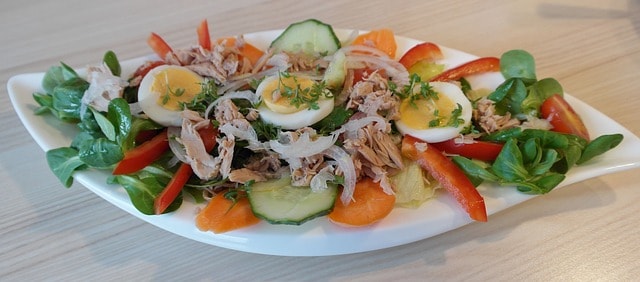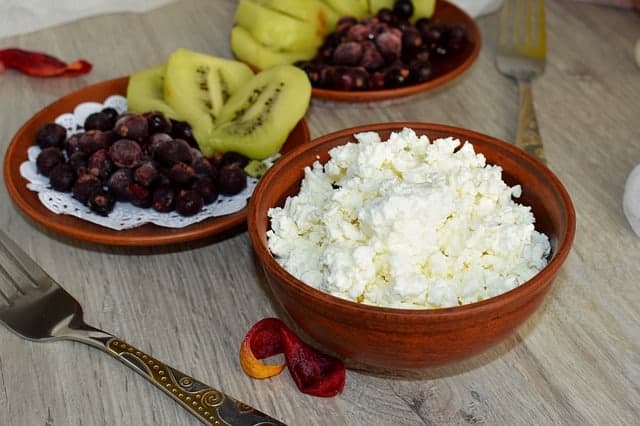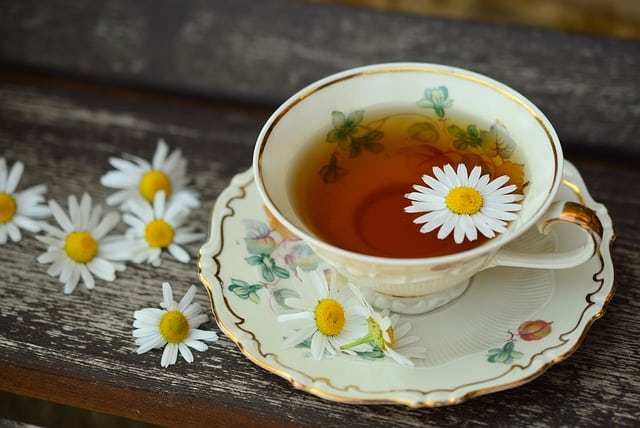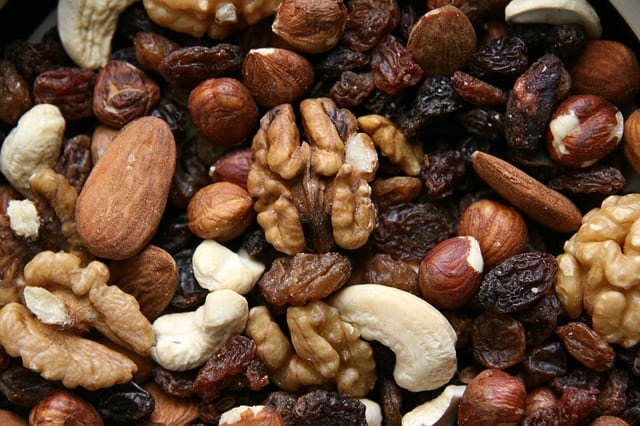For children living with mental health conditions like obsessive-compulsive disorder (OCD), a healthy diet and regular exercise are essential for managing the symptoms.
So, what is OCD?
The Mayo Clinic defines obsessive-compulsive disorder (OCD) as a chronic or cyclic form of anxiety that stems from irrational thoughts and fears, worries, and concerns (obsessions)–i.e. repeatedly washing one’s hands or checking to see if the stove is off.
These obsessions then lead individuals to engage in repetitive behaviors (compulsions). As a result, these thoughts and behaviors disrupt daily activities, causing severe anxiety and distress. [1]
The purpose of compulsions is to relieve the stress of the obsessions. [1]It’s important to note that the exact cause of OCD varies and has not been officially determined.
While there is not a tremendous body of research on the connection between OCD and foods, most researchers, psychologists, and physicians agree that healthy foods, along with anti-anxiety meds and/or psychotherapy, can improve OCD symptoms for some children.
Therefore, your child needs to consume a variety of healthy foods regularly. Why? Well, because when your child becomes hungry, their glucose level (blood sugar) declines, causing them to feel sluggish and irritable, exacerbating their OCD symptoms. [2]
The good news is, with proper treatment, children with OCD can live productive and successful lives. Healthy foods, along with your child’s prescribed treatment plan, can help them better manage OCD symptoms.
Table of Contents
- Foods to Ease Your Child’s OCD Symptoms
- Salmon, Tuna, Eggs & Other Omega-3 Foods
- Cottage Cheese, Yogurt, Skim Milk & Other Low-Fat Dairy Products
- Oatmeal, Popcorn & Other Whole Grains
- Berries, Broccoli & Other Fruits and Veggies
- Chamomile Tea
- Hypoglycemic Foods (i.e. Nutty Trail Mix, Raisins, Peanut Butter with Bananas, etc.)
- Sesame Seeds, Spinach, Egg Whites, Turkey & Dark Chocolate
- Water
- In Summary
Foods to Ease Your Child’s OCD Symptoms
Listed below are healthy foods that may help ease your child’s OCD symptoms:
Salmon, Tuna, Eggs & Other Omega-3 Foods

While the studies on omega-3 in connection to OCD are limited, many parents of the children I treat for OCD often report that omega-3 foods have eased their children’s symptoms.
Therefore, if your child suffers from OCD, you may want to add or increase his/her consumption of salmon, tuna, or eggs. These foods contain healthy amounts of omega-3 fatty acids, which are known to ease stress and relieve anxiety.
Fatty acids are crucial for good emotional health. Recent studies on OCD and foods found that foods rich in omega-3 can reduce anxiety in some children and adults. [3], [7] Keep in mind that our bodies do not naturally produce omega-3, so it has to be manually added to your child’s diet.
Note: If your child isn’t big on fatty, cold-water fish (i.e. salmon, halibut, sardines, mackerel, or tuna) like most children, and if they are allergic to or not fond of eggs, they can consume other foods rich in omega-3, such as sunflower seeds, pumpkin seeds, flaxseeds/flaxseed oil, chia seeds, canola oil, broccoli, spinach, Brussel sprouts, and/or walnuts. [3]
Walnuts and seeds are particularly good for children with OCD because they are also rich in zinc and iron, minerals that can ward off mental fogginess and distress. [7]
Cottage Cheese, Yogurt, Skim Milk & Other Low-Fat Dairy Products

When treating children with OCD, I often recommend that they add or increase their consumption of low-fat dairy products.
Low-fat dairy products like low-fat cheese, yogurt, and milk are rich in protein, which help normalize your child’s glucose (blood sugar) level. [4] Low-fat dairy also stabilizes your child’s tryptophan level.
Tryptophan is an amino acid (cellular building block) that triggers calmness and relaxation in the body. [4] According to a recent study on OCD and low-fat dairy products, a healthy immune system is connected to a healthy “gut.” [8] Researchers also found that a healthy “gut” is also linked to a healthy mind.
Moreover, scientists now believe that anxiety-based disorders like OCD are linked to harmful and unhealthy bacteria in the stomach and intestines. [8]
As a result, many physicians, psychologists, scientists, and researchers recommend that people with OCD ramp up their consumption of natural probiotics (often found in yogurt and kefir). [8]
Probiotics prevent unhealthy bacteria from increasing, which helps keep your child’s digestive system healthy. Furthermore, a 2011 study on probiotics and anxiety (given to mice) found that there was a reduction in bodily stress, compulsive behaviors, and anxiety in the mice that were given the probiotics. [8]
Therefore, you may be able to reduce your child’s OCD symptoms simply by making sure he/she has healthy, balanced meals and snacks that include low-fat dairy products.
Note: If your child doesn’t care for, or has an allergy to milk, yogurt, or cheese, then they can still receive the benefits of probiotics through sauerkraut, kefir, kombucha, apple cider vinegar, brine-cured olives, salted gherkin pickles, etc.
Oatmeal, Popcorn & Other Whole Grains

Most of my young clients with OCD love when I tell their parents to give them popcorn more often as a snack. The great thing about popcorn, oatmeal, and other whole grains is that they are low-calorie and nutritious.
Whole grains are the healthiest parts of grains and they provide the body with energy without the after-effects (the “crash”) of refined grains. [4]
And because they are complex carbohydrates (the healthy kind), they help people produce higher levels of serotonin, the “feel-good” hormone that triggers calmness and relaxation. [4]
Also, according to the Association for Comprehensive Neuro-Therapy, (ACTN), boosting your child’s consumption of whole grains and restricting their consumption of refined grains (i.e. white flour, white bread, and white rice) may help your child maintain a healthy blood sugar level and ease your child’s OCD symptoms. [6]
Note: If your child doesn’t like oatmeal or popcorn, don’t fret; they can still get the benefits of whole grains through the following foods: barley, wild rice, and brown rice.
Berries, Broccoli & Other Fruits and Veggies

Although there isn’t a lot of research on fruits and vegetables as an OCD treatment, they are good for your child’s body, and therefore it can’t hurt to add more of them to their daily diet.
The best thing about berries, broccoli, and other fruits and veggies (i.e. citrus foods and tomatoes) is that they are chock full of antioxidants like vitamin C and beta-carotene, which reduce stress in the body, leading to a calmer mind. [4]
They also help fight illnesses, infections, and diseases and promote mental health, which means they may help reduce OCD symptoms. These fruits and veggies have high levels of phytonutrients, which can calm the mind. [7] They also support brain development and strengthen cognitive functions. [3]
And because these healthy foods consist primarily of fiber and water, they tend to make your child feel “fuller” more quickly and for a longer amount of time.[4]
A healthy mind is linked to a healthy body, so by keeping your child’s body in tip-top shape, you’ll provide them with the tools to battle their OCD symptoms.
Note: If your child doesn’t like berries or broccoli, you can give them these other antioxidant-rich foods: mustard, collard, and turnip greens, winter squash, bell peppers, and Brussel sprouts.
Chamomile Tea

When I ask parents of the children with OCD that I treat if any foods appear to help with OCD, some tell me that chamomile tea has helped their children. Chamomile tea can be beneficial for some children with OCD because of its soothing properties.
Chamomile tea can lower stress in the body, thereby reducing anxiety, headaches, mental confusion, tension, shakiness, insomnia, irritability, and nervousness. [3]
In fact, according to a 2009 University of Pennsylvania study on the benefits of chamomile in the treatment of anxiety disorders, chamomile tea or supplements (for adults) can ease anxiety symptoms in some individuals. [9]
It is important to note, however, that chamomile is not recommended for pregnant women because it heightens the risk of a miscarriage.
Avoid chamomile if your child is allergic or hypersensitive to the sunflower family (i.e. daisies, sunflowers, and asters) because it could cause them to experience an allergic reaction. [10]
Hypoglycemic Foods (i.e. Nutty Trail Mix, Raisins, Peanut Butter with Bananas, etc.)

If you have a child with OCD and you’ve never heard of hypoglycemic foods, you may want to brush up on them.
Hypoglycemic foods like nutty trail mix, raisins, and peanut butter with bananas may help stabilize your child’s glucose (blood sugar) level, lowering their risk of activating cortisol (a stress hormone) in the body. Lower stress levels may lead to a reduction of OCD symptoms in some children. [3]
Sesame Seeds, Spinach, Egg Whites, Turkey & Dark Chocolate

Have you ever wondered why some people become sluggish after a hearty, turkey-based Thanksgiving dinner? Well, most likely it’s because turkey is rich in tryptophan, also known as L-tryptophan.
L-tryptophan is the amino acid responsible for metabolizing (breaking down) protein in the body so it can be used for energy. [8] It is responsible for triggering serotonin, the “feel-good hormone” that calms your mind, balances mood, eases anxiety, decreases inflammation in the body, and helps you sleep more soundly. [8]
It also helps your child’s body (and mind) heal more efficiently and quickly. [8] Spinach, sesame seeds, eggs whites, turkey and dark chocolate contain high levels of tryptophan.
My patients love when I recommend that they add chocolate to their daily diets. Dark chocolate (not milk chocolate… sorry kids!) may help ease OCD symptoms. [11] The catch is, the chocolate must be pure, dark chocolate void of any sugars and milk to be effective.
Dark chocolate not only eases bodily stress, but it can also ease your child’s mind and boost his/her mood. (7) According to a 2009 study on dark chocolate and anxiety, some people with anxiety may experience a reduction in anxiety symptoms after consuming dark chocolate. [12]
Water

Did you know that the human body is made mostly of water? Because of this, the body functions best when it is properly hydrated. [7] Dehydration can cause mood swings, triggering or worsening OCD symptoms. (7) Water helps transport anxiety-busting hormones through your child’s body.
Note: I have noticed that my child clients with OCD who drink at least 64oz of water a day fare much better than those who drink very little or none at all.
In Summary
Obsessive-compulsive disorder (OCD) symptoms are the same for both adults and children. However, OCD symptoms in children are harder to identify. [13] Some children may not understand what’s happening to them or recognize that what they are experiencing is “abnormal.”
As a result, they may not know they need help. Many times, this condition is mistaken for other mental health conditions like ADHD or depression, especially if it interferes with their ability to perform at school. [13]
When OCD presents during childhood, there is an increased risk that the child will also develop other mental health conditions, such as ADHD, other anxiety disorders, and/or tics. [13]
Keep in mind that OCD appears to be genetic, so there’s a good chance you or a relative of your child also has some degree of OCD. [13]
Some studies suggest that diet plays a role in the development of anxiety disorders, so it makes sense that providing healthy foods for your child may ease his/her OCD symptoms. [14]
OCD is typically treated with medication and therapy (counseling) and although research on the effectiveness of using foods to ease OCD symptoms is limited, a healthy diet, regardless of the purpose, will increase your child’s chances of conquering their anxiety.
Even though the hallmark signs of this condition are irrational thoughts and repetitive behaviors, a nutritious diet could help improve your child’s physical health and cognitive function, so he/she can live a happy and productive life.
References
- Mayo Clinic. (2018). Obsessive-compulsive disorder (OCD).
- WebMD. (2018). Tips for living with OCD.
- Naidoo, U. (2016). Nutritional strategies to ease anxiety. Harvard Medical School.
- Lakhan, S. E. & Vieira, K. F. (2008). Nutritional therapies for mental disorders. Nutrition Journal, 7(2).
- Buydens-Branchey, L., Branchey, M., & Hibbeln, J. R. (2008). Associations between increases in plasma n-3 polyunsaturated fatty acids following supplementation and decreases in anger and anxiety in substance abusers. Prog Neuropsychopharmacol Biol Psychiatry, 32, 568-575.
- Association for Comprehensive Neuro-Therapy, (ACTN). (2018). 9 natural and integrative approaches to OCD and anxiety.
- The Center of the Treatment of Mood and Anxiety Disorders. (2017). Generalized anxiety disorder: Foods that help anxiety.
- Segal, J. & Robinson, L. (2018). Healthy foods for kids. Helpguide.org.
- Amsterdam, J. D., Li, Y., Soeller, I., Rockwell, K., Mao, J. J. & Shults, J. (2009). A randomized, double-blind, placebo-controlled trial of oral Matricaria recutita (chamomile) extract therapy for generalized anxiety disorder. Journal of Clinical Psychopharmacology, 29(4), 378-382.
- Drugs.com. (2017). Chamomile.
- Sunni, A. A. & Latif, R. (2014). Effects of chocolate intake on perceived stress: A controlled clinical study. International Journal of Health Sciences, 8(4), 393-401.
- Martin, F. J., Rezzi, S., Peré-Trepat, E., Kamlage, B., Collino, S., Leibold, E., Kastler, J., Rein, D., Fay, L. B., & Kochhar, S. (2009). Metabolic effects of dark chocolate consumption on energy, gut microbiota, and stress-related metabolism in free-living subjects. Journal of Proteome Res., 8(12), 5568–5579.
- International OCD Foundation. (2018). What is different about OCD in kids?
- Zaimes, J. M. S. (1995). A case study of obsessive-compulsive disorder:
Some diagnostic considerations. Jefferson Journal of Psychiatry, 12 (2).









